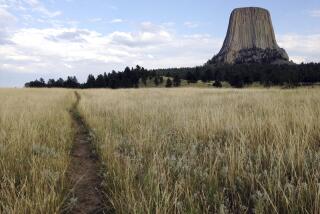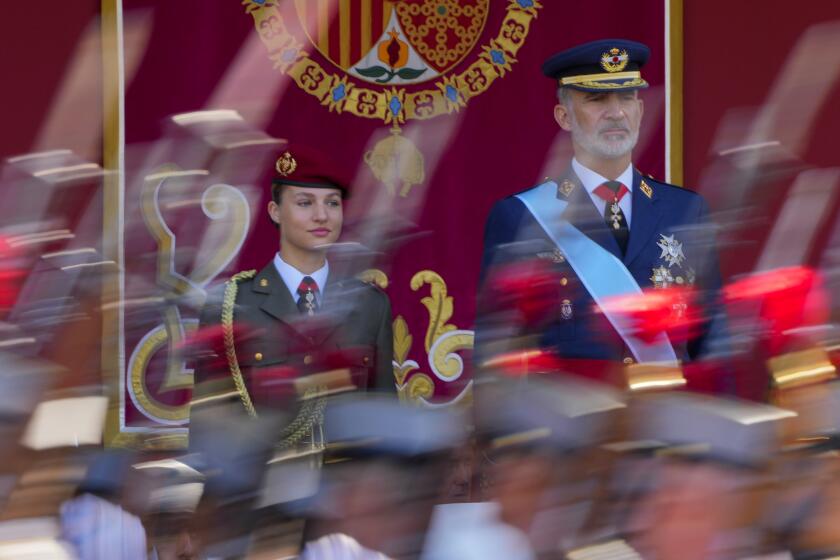London Bristles With Police
It was Thursday morning and the Earl’s Court Underground station in West London was crawling with police.
Three officers stood at the entrance, four hovered near the turnstiles and, above the train platform, two sharpshooters strolled along a walkway with MP-5 submachine guns clutched to their chests.
Three weeks after the July 7 bombings, London was awash with police officers openly toting guns -- underscoring just how quickly the city has departed from its image as a place where “bobbies” in helmets patrolled armed with nothing more than a nightstick and a smile.
Many people, such as 37-year-old Carlo Guimaraes, didn’t mind. In fact, the Brazilian-born personal trainer seemed to welcome the attention after two officers closed in on him for questioning and a search of his backpack before letting him board the subway.
“It’s for safety and we have to help them,” he said about the inconvenience. “So why not?”
Officers who are proud that they don’t carry guns say they’re torn about the fading British tradition.
“I think people are going to have to get used to much more armed police and more police intervention in their day-to-day lives,” said Kevin Shanahan, a 27-year veteran who commands 150 officers on the city’s transit police force.
“Believe you me, we don’t like to have people with guns but we’ve got to,” he said. “A little bit of naivete goes. People get a little bit harder. Innocence is lost, you know.”
If London’s top cop has his way, more of that innocence will die as an increasing portion of the 30,000-strong Metropolitan Police force takes up arms to fight potential suicide bombing threats.
“We will have to strengthen, in the next year, the firearms capability of the Metropolitan Police,” said Ian Blair, commissioner of the force, warning that terrorist cells could be plotting more strikes.
Law enforcement’s push for an increased number of armed officers represents a dramatic break with its past. The urban police force dispensed with handguns altogether during the two decades after World War II, recreating the 19th century ideal.
Although the reality gradually has changed since the mid-1960s, London still lags far behind American cities such as Los Angeles, where every officer is issued a gun. Only 2,000 Metropolitan Police officers are authorized to use firearms.
Until recently, the use of guns here has been sparse and mostly kept under wraps. In addition to those assigned to special details, such as guarding foreign embassies or arresting high-risk suspects, a number of select armed officers drive the streets in “armed response vehicles” to provide backup if needed for their unarmed colleagues. In the last few years, the number of calls for armed backups has risen sharply, from 132 in 1991 to 2,490 a decade later.
Despite the increase, London police have a record of shootings that would seem miraculous in American cities of comparable size. According to Associated Press, from 1997 to 2004, London officers fired their weapons 20 times, killing seven people. Two of those who died were shot by mistake.
In contrast, Los Angeles County Sheriff’s Department officers fired 120 shots during a single incident in May.
Still, those few London incidents have hit a nerve with the British public, and some say they are unsettled by the increased visibility of armed police officers, even after the recent terrorist bombings and botched attacks two weeks later.
“They only serve to cause more panic,” said Michael Brown, a 66-year-old retired public school art teacher. “You see more and more armed police, and more and more of these cement barriers.”
Standing outside the former residence of novelist George Orwell, who famously predicted the rise of the Big Brother totalitarian state, Brown said, “Typically British, we don’t stand up and say we don’t want this. It’s too much over the top.” Like a number of residents, Brown said he was outraged by the recent incident in which London police shot to death a Brazilian man they mistook for a would-be bomber.
Yet after a brief outcry, London appeared to have accepted the police department’s apology, echoed by Prime Minister Tony Blair, and moved on.
Police announced the arrest Thursday of nine men in Tooting, in southwest London, even as three suspects in the failed July 21 bombings remained at large. No explosives were found.
In the meantime, Asif Allani, a 23-year-old cashier at a candy stand in Victoria Station, said he wanted to see more police like the officers and sniffer dogs that have showed up in recent days.
“It’s good! It’s good!” said Allani, who added that if he had his way, there would be a police officer on every subway car. “We can see some extra security in this country and it’s good for everybody.”
That was before Thursday’s show of force. Transit police, reinforced by hundreds of colleagues from other cities, stormed the subways while Metropolitan Police officers also swarmed the transportation lines and other crowded areas of the city.
At Waterloo Station, scores of police mingled with commuters. The number was smaller at Earl’s Court Station, but the officers still made a sharp impression, especially among the estimated 80 individuals they stopped during the morning rush hour for questioning and searches.
Police said those targeted were young men carrying backpacks and appearing to be of South Asian, Arab, African or East European ethnicity.
Among them was Guimaraes, the Brazilian personal trainer.
Stopped on the basis of his ethnic appearance and backpack, he only shrugged over the 10 minutes lost while his bag was searched and he was quizzed about his background and when he had entered the country.
Guimaraes expressed nothing but gratitude.
“It don’t feel that it is a kind of racist stuff, no. Absolutely,” he said.
“If they’re not here and investigating everybody, I could be carrying a bomb.”
Times special correspondent Vanora McWalters contributed to this report.
More to Read
Sign up for Essential California
The most important California stories and recommendations in your inbox every morning.
You may occasionally receive promotional content from the Los Angeles Times.










